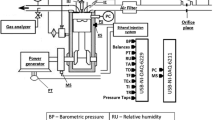Abstract
The need for using environmentally friendly energy carriers for mobile heat power plants (HPPs) is grounded. Ecologically friendly sources of energy, such as natural gas as well as renewable methyl and ethyl alcohols, are investigated. In order to develop, determine, and optimize the composition of environmentally friendly energy carriers for an HPP, the latter has been tested when working on diesel fuel (DF), compressed natural gas (CNG), and methanol and ethanol fuel emulsions (MFE, EFE). It has been experimentally established that, for the application of environmentally friendly energy carriers for a 4Ch 11.0/12.5 diesel engine of a mobile fuel and power plant, it is necessary to maintain the following ratio of components when working on CNG: 80% gas and 20% DF primer portion. When working on an alcohol mixture, emulsions of the following composition were used: 25% alcohol (methanol or ethanol), 0.5% detergent-dispersant additive succinimide C-5A, 7% water, and 67.5% DF. When this diesel passed from oil DF to environmentally friendly energy sources, it allowed for the reduction of the content of exhaust gases (EG) (1) when working on CNG with recirculation of exhaust gases (EGR) (recirculation was used to eliminate the increased amount of nitric oxides by using CNG): carbon black by 5.8 times, carbon dioxide by 45.9%, and carbon monoxide by 23.8%; (2) when working on MFE: carbon black by 6.4 times, nitrogen oxides by 29.6%, carbon dioxide by 10.1%, and carbon oxide by 47.6%; (3) when working on EFE: carbon black by 4.8 times; nitrogen oxides by 40.3%, carbon dioxide by 26.6%, and carbon monoxide by 28.6%. The prospects of use of environmentally friendly energy carriers in diesels of mobile HPPs, such as natural gas, ethanol, and methanol, has been determined.
Similar content being viewed by others
References
V. E. Fortov and A. A. Makarov, “Innovation and development trends in the energy industry worldwide and in Russia,” Phys.-Usp. 52, 1249–1265 (2009).
D. J. Arent, A. Wise, and R. Gelman, “The status and prospects of renewable energy for combating global warming,” Energy Econ. 33, 584–593 (2011).
A. Lif and K. Holmberg, “Water-in-diesel emulsions and related systems,” Adv. Colloid Interface Sci. 123–126, 231–239 (2006).
V. E. Fortov and O. S. Popel’, “The current status of the development of renewable energy sources worldwide and in Russia,” Therm. Eng. 61, 389–398 (2014). doi 10.1134/S0040601514060020
V. A. Markov, V. V. Biryukov, and S. I. Kas’kov, “Ethanol used as an environmentally sustainable energy resource for thermal power plants,” Therm. Eng. 63, 628–635 (2016). doi 10.1134/S0040601516090044
V. A. Markov, S. N. Devyanin, and V. I. Mal’chuk, Fuel Injection and Pulverization in Engines (MGTU im. N. E. Baumana, Moscow, 2007) [in Russia].
V. N. Baskov and E. S. Pantskhava, “Motor biofuels: The state and prospects of technology development in Russia and in the world,” Therm. Eng. 60, 270–273 (2013). doi 10.1134/S0040601513040022
K. A. Subramanian, “A comparison of water–diesel emulsion and timed injection of water into the intake manifold of a diesel engine for simultaneous control of NO and smoke emissions,” Energy Convers. Manage. 52, 849–857 (2011).
J. C. Conklin and J. P. Szybist, “A highly efficient sixstroke internal combustion engine cycle with water injection for in-cylinder exhaust heat recovery,” Energy 35, 1658–1664 (2010).
S. M. Borshchevskii, “Additives for lubricating oils,” Mir Nefteprod. Vestn. Neft. Kompanii, No. 5, 42–45 (2007).
V. A. Likhanov and O. P. Lopatin, “Investigating speed modes of Minsk motor plant diesels running on natural gas,” Inzh. Zh.: Nauka Innovatsii, No. 1, 12 (2017). doi 10.18698/2308-6033-2017-1-1573
V. A. Likhanov and O. P. Lopatin, “Modeling of nitrogen oxides emission in the cylinder of tractor gas-diesel engine,” Trakt. Sel’khozmash., No. 7, 3–8 (2016).
Author information
Authors and Affiliations
Corresponding author
Additional information
Russian Text © V.A. Likhanov, O.P. Lopatin, 2017, published in Teploenergetika.
Rights and permissions
About this article
Cite this article
Likhanov, V.A., Lopatin, O.P. Use of natural gas, methanol, and ethanol fuel emulsions as environmentally friendly energy carriers for mobile heat power plants. Therm. Eng. 64, 935–944 (2017). https://doi.org/10.1134/S0040601517120060
Received:
Accepted:
Published:
Issue Date:
DOI: https://doi.org/10.1134/S0040601517120060




